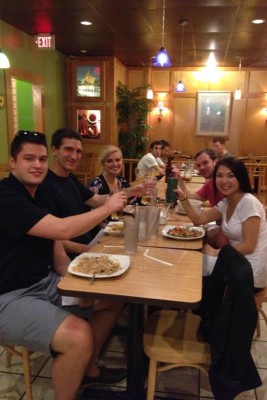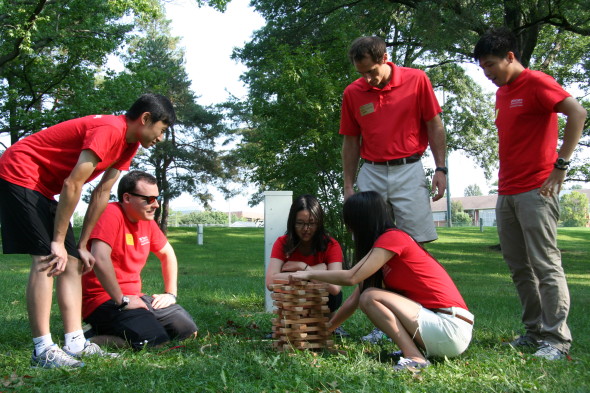A high-performing team is the holy grail of leadership. But how do you build a strong team in practice? The beauty of Olin’s Executive MBA program is the abundance of opportunities to learn, apply, and practice team-building skills.
Executive MBA alumni Eric Willis and Ali Ahmadi, EMBA Academic Director Lee Konczak, and Associate Professor of Organizational Behavior Andrew Knight summarize some of the more salient lessons about team-building from the Executive MBA program and their professional lives:
A Shared Purpose
As part of the Leadership Residency, Lee Konczak, academic director of the Executive MBA Program and senior lecturer on organizational behavior and leadership development, administers a team development survey to measure how well the student teams function.
The assessment is Olin’s way “of defining for EMBA teams what a good team looks like,” Konczak said. “Teams do better when they have shared goals, plan ahead, and communicate. In some cases, it’s obvious when teams aren’t on the same page using this assessment.”
According to Konczak, commitment to a shared purpose and a willingness to plan are the two most important team-building takeaways for executives in the program.
Diversity of Perspectives and Experience
Eric Willis, EMBA 43, was a senior brand manager when he started the EMBA Program. He was promoted to a brand director during the program and is now director of marketing at Nestlé Purina Petcare. For him, the team-building aspect of the Executive MBA Program was an opportunity to practice skills he’d learned at Nestlé with a completely different and diverse group of professionals.
“One of the things I loved most about the EMBA program was that it was such a diverse group of people with different points of view and different backgrounds, all coming together in one place,” Willis said. “On your team, you’ve got to figure out how to leverage everyone’s strengths to achieve a common goal.”
At Nestlé Purina, Willis regularly brings groups of disparate team members together, including finance and product development participants, to agree on mission and vision. Some of the challenges include developing trust, addressing different sets of values, and communication.
“To me, building a strong team means getting diversity of thought. It means respecting people’s different points of view,” he said. “When I think of building a strong team, I think of empowering people to make decisions, and I think of leveraging what everybody brings to the table and trying to find a way to use everybody’s different perspectives to reach a common goal.”

An Environment of Trust and Respect
Entrepreneurship is an area in which building strong teams—and building them early—is critical. As an EMBA student, Ali Ahmadi, EMBA 44, leapt fully into entrepenreurship, co-founding drone 3D software startup “Strayos” (formerly AirZaar), with a fellow student. He knows firsthand how important it is that teams work well when the stakes are high and the rewards are not guaranteed.
“Early stage founders often don’t realize that the idea or product is not the only factor motivating the talent; it’s also the willingness to follow their leader into an environment where the odds are stacked against them in succeeding,” he says. “When you build a team that trusts and respects you as a leader, they will go through a wall of fire to reach the common goal but if the trust and respect are neglected, then very little can be done to salvage it,” he says.
Be Open to Feedback
Andrew Knight, associate professor of organizational behavior at Olin, finds that one of the biggest roadblocks for entrepreneurs is cultivating and developing a sense of shared ownership—“not in an equity sense,” Knight said, “but in terms of the feeling of ownership that the team members have over the venture. There is kind of an asymmetry in people’s investment in the project at the outset.”
Knight suggests leaders invite input from those joining the team, while at the same time creating boundaries: “Encourage new team members to make contributions and suggest changes to the venture, but pair that with clearly communicating where the entrepreneur is less willing to make changes.”
This clarity—inviting input within a mutually understood structure—“applies in almost any creative team where there is a need to get people feeling ownership—especially implementation and innovation,” Knight said.
The importance of this delicate balance is supported by recent research by Knight and Associate Professor of Organizational Behavior Markus Baer, who identified three behaviors of successful lead entrepeneurs in the earliest stages of a venture.




 Luckily I’ve had the fantastic fortune of being placed on a team of brilliant individuals, who all can play as a team. We work hard, we get the work done, but we make sure we are enjoying ourselves and building the team and our relationships along the way. We have fun.
Luckily I’ve had the fantastic fortune of being placed on a team of brilliant individuals, who all can play as a team. We work hard, we get the work done, but we make sure we are enjoying ourselves and building the team and our relationships along the way. We have fun.


